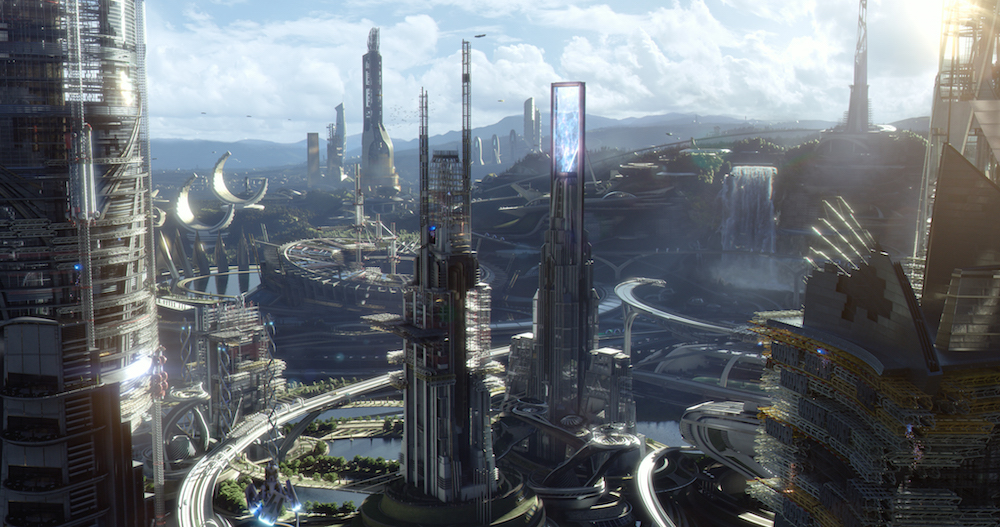Jetpacks! Robots! 'Tomorrowland's' Awesome Vision of the Future

Spoiler alert: This story contains references to plot points in the movie "Tomorrowland."
If the movie "Tomorrowland" is anything to go by, the future will be filled with jetpacks, flying trains and, of course, evil robots.
The upcoming Disney film revolves around a futuristic world located in another dimension, which can be accessed by a portal or a time-traveling rocket ship. It's up to a former boy genius and a bright teenage girl to save this future from global warfare and ecological demise.
Here are just a few of the futuristic technologies you can expect to see in "Tomorrowland," which blasts into theaters today (May 22). [Science Fact or Fiction? The Plausibility of 10 Sci-Fi Concepts]
Jetpacks
Who wouldn't want to get around by jetpack? Apparently the creators of "Tomorrowland," which is also the name of theme lands at many Disney parks, felt the same way. Actor George Clooney plays Frank Walker, a former boy genius who grew up to be a brilliant but disillusioned inventor. Walker builds his own jetpack in the 1960s, but the device doesn't function as well as he hopes. Luckily, it earns him a ticket to Tomorrowland, a futuristic world where jetpacks not only work, but are commonplace.
'Teleportation' badges
Sign up for the Live Science daily newsletter now
Get the world’s most fascinating discoveries delivered straight to your inbox.
There are a number of ways to get to Tomorrowland, and one of them is by touching a tiny badge that instantly teleports you there. But the teleporter badge works only for people who have been specially handpicked for their brilliance or potential, such as teenage genius Casey. The catch is, the badge teleporters turn out to be nothing more than an advertisement for a version of Tomorrowland that no longer exists — unless Casey can convince Frank that it can be saved.
Time-traveling rockets
Another way to get to Tomorrowland is to take a rocket that can travel to the future, via another dimension. The rocket — which launches, improbably, from beneath the Eiffel Tower — is supposedly powered by "tachyons," hypothetical particles that can move faster than light. In reality, most physicists reject the existence of tachyons because the known laws of physics cannot explain such particles. But if it means you can travel to the future, who's complaining?
Flying trains
Once you arrive in Tomorrowland, you may want to hop on one of the flying trains that snake through the air as if on invisible tracks. These "Tesla" trains may be a nod to the 19th-century Serbian-American inventor Nikola Tesla. In the film, Tesla is one of four architects of Tomorrowland, along with American inventor Thomas Edison, French architect Gustave Eiffel and French novelist Jules Verne.
Or, perhaps the trains are a reference to the electric car company Tesla Motors, whose CEO, Elon Musk, has developed designs for a hypothetical high-speed transport system based on pneumatic tubes, dubbed the Hyperloop. [Humanoid Robots to Flying Cars: 10 Coolest DARPA Projects]
Childlike artificial intelligence
Of course, no futuristic world would be complete without artificially intelligent robots. One of the film's main characters is a childlike android named Athena, whose job is to recruit bright young humans to help avert a future global collapse and the end of civilization. Athena is not meant to have ideas or emotions, but after she meets the young Frank Walker, she finds herself developing feelings — one hallmark of humanlike intelligence, or "strong AI."
Evil robots
Like any good Disney film, Tomorrowland has villains. Some of these come in the form of not-so-intelligent Terminator-style robots. The bots are sent to kill Casey before she makes it to Tomorrowland, but despite their ray guns, they are thwarted by the many booby traps in Frank's house, including magnetic walls, a force field that repels intruders and a door that slices people up like a cheese grater.
Thinking Machine
Perhaps the most important piece of hypothetical technology in the film is the so-called "Thinking Machine," created by Frank Walker's nefarious counterpart, the brilliant scientist David Nix, played by Hugh Laurie. The machine acts as a giant antenna for broadcasting pessimistic thoughts into the minds of humanity, in the hopes of averting global disaster. But it backfires, and these negative thoughts about the future become a self-fulfilling prophecy. As the film's not-so-subtle message makes clear, the only thing that can save humanity from disaster is the power of positive thinking.
Follow Tanya Lewis on Twitter. Follow us @livescience, Facebook & Google+. Original article on Live Science.










